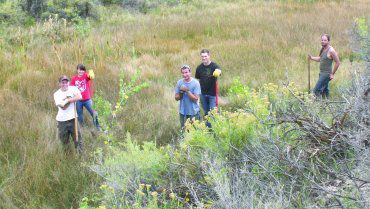The Utah Division of Wildlife Resources and the USU Eastern Sun Center students teamed up to improve wildlife conditions and habitat in Emery County.
The first part of the project included a trip to Desert Lake to install wood duck boxes. These boxes for nesting get the ducks up off the ground and help with ensuring more production of young ducks. The eggs are protected so small animals don’t raid the nests.
The DWR provided the following information on wood ducks. Wood duck breeds are scattered in areas across the United States, southern Canada, and Cuba. Northern populations migrate south for the winter, and major wintering areas include California and the southern United States. The species occurs year-round in Utah, although it is more common in the state during winter. Wood ducks prefer marshes and ponds near woodlands, and are especially fond of flooded forests.
The wood duck is a cavity nester that typically nests in hollow trees or man-made nest boxes; nests are almost always near water. Nine to 15 eggs are laid and incubated for about one month by the female alone. Wood ducks often lay their eggs in the nests of other females, so some nests may contain 30 or more eggs. Young are able to fly at about nine weeks of age. Wood ducks eat primarily plant material during the winter, and insects during the spring and summer.
During the mid-1900s, wood duck populations were much reduced from current levels. Fortunately, habitat improvements and better wildlife management practices have allowed the species to make a rapid recovery.
The second leg of the project found the group at the Huntington Game Farm where they planted cottonwood seedlings in a marshy area. This was done to increase the habitat at the farm for the yellow billed cuckoo that has been spotted at the game farm. Yellow billed cuckoos arrive in late May or early June and breed in late June through July. Cuckoos typically start their southern migration by late August or early September.
Chris Wood from the DWR helped the Sun students with the project. He thanked the volunteers for their hard work on the projects which will help wildlife in Emery County.
Jason Fredrickson is one of the 20 leaders for the Sun Center. The service club has 100 volunteers that attend USU Eastern. Another project they were involved with recently was harvesting potatoes to donate to the food banks in the area.
Other students involved this day included: Nathan Pollaehne from Huntington, Riley Messick from American Fork, Carolyn Thornton from Tampa, Fla. and Levi Simmons from Clawson.
Sun Center students help with DWR habitat projects

"Volunteers this day include: left to right; Jason Fredrickson, Carolyn Thornton, Nathan Pollaehne, Riley Messick and Levi Simmons."
